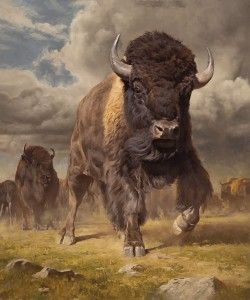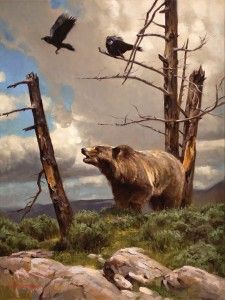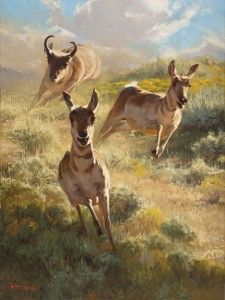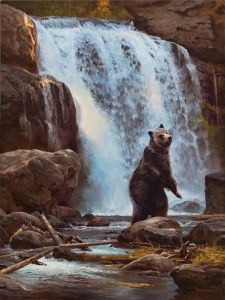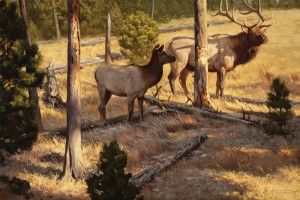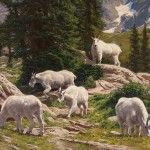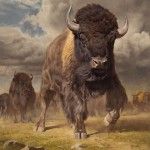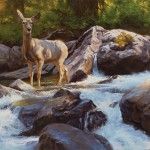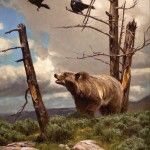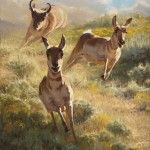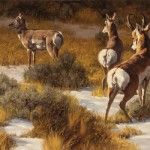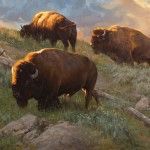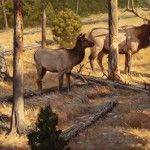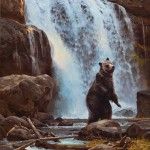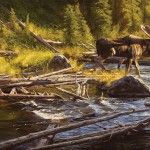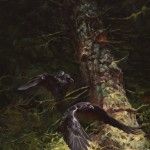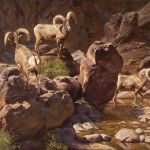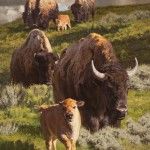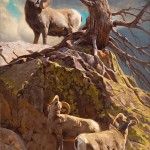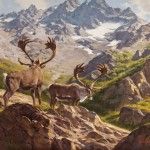Dustin Van Wechel accelerates into the upper echelons of America’s western artists
By Norman Kolpas
This story was featured in the March 2014 issue of Southwest Art magazine. Get the Southwest Art March 2014 print issue or digital download now–then subscribe to Southwest Art and never miss another story!
The bison bull charged. As a ton of muscled beast came rocketing toward him, nostrils flaring, sharp horns glinting, Dustin Van Wechel lay belly-down in the dust, transfixed.
“Many people have asked me how I wasn’t killed in getting the reference images for this painting,” he says of HEADSTRONG. And many more will likely ask that question this month, while the work is on view in Masters of the American West—the annual event at Los Angeles’ Autry National Center that has come to be considered one of the nation’s leading western art shows. Van Wechel, 39, is making his first appearance in the show with five paintings, of which HEADSTRONG is the largest.
The 48-by-40-inch oil perfectly represents all of the qualities that have brought Van Wechel serious recognition in the 12 years since he decided to devote himself full time to fine art. It possesses the compelling feeling that the artist was actually there, capturing a firsthand experience: How did he avoid catastrophe? (More on that question later.) There’s also a convincing sense of place, with rugged terrain and immense stormy skies that could only be the American West. Mix in a deft handling of his medium in an approach he describes as “painterly representationalism,” and it all adds up to what could well be called an unmistakable signature style.
The seeds of Van Wechel’s style were solidly present from early childhood. “I’ve been drawing my entire life,” he says, citing compelling evidence. “My mother literally saved every drawing I ever made, from the time I was first able to pick up a pencil.” He modestly claims that such recognition and support played an even greater role in the development of his early talent than any particular aptitude. “The more positive feedback I got, the more I did it. Over time, my drawings got better and better through sheer volume. Eventually, art became part of who I am.”
A love of nature was also there from the start. Up to the time he entered third grade, his family lived in Quartzsite, AZ, near the California border, a rock hound’s mecca amidst the vast Sonoran Desert. “We’d go on four-wheeler trips into the desert, and I spent a lot of time outside catching lizards, snakes, and tarantulas,” he recalls. After they moved to suburban Phoenix, the Van Wechels still went camping on many weekends. Animals were such a natural subject for him that the first piece he ever sold was a pencil drawing of a white-tailed deer. “The dentist my mother worked for as a dental assistant commissioned it from me. He paid me $50—a mind-boggling amount for a 12 year old,” he says.
In middle school, Van Wechel began regularly winning awards for his work at the Arizona State Fair. During high school, he took a more practical tack, gravitating toward a career in illustration and graphic design. In 1995, he enrolled at Collins College, a two-year trade school in Tempe, AZ, that featured courses using “all the cutting-edge technical equipment that was beginning to take over print publishing and advertising at the time.”
While there, he also came to realize that being an artist could mean more than simply creating works and selling them in galleries, exalted though such a goal might be. “The illustration professor, Rusty Walker, an artist known for his watercolors, opened my eyes to what the world of art really meant, showing me that there was a whole world of work you could go into that an artist could have his hands on,” he remembers.
With that in mind, Van Wechel soon moved to Southern California to work in the art department of a computer software company, staying almost two years. That first professional experience remains vitally important today: “It gave me an appreciation for deadlines, and to this day I operate my fine-art life with a daily work schedule like a business. But the biggest contribution from that job was meeting my wife, Yvonne, who was working as the traffic manager there.” They’ll celebrate their 14th wedding anniversary later this year.
He next went to an advertising agency to work as an art director on campaigns for many high-end international clients. Success, however, forced him to set aside the art he’d been making for his own pleasure on the side. “The new job was brutal. I was putting in all-nighters,” he says. “That’s when I really decided I wanted to be a fine artist.”
In 2001, he and Yvonne headed to Phoenix. There, Van Wechel took up “a little less stressful work” in a design firm, allowing himself time to get back into fine art. Around then, to gain inspiration and information for his planned career shift, he also visited a wildlife art show at the Henry Doorly Zoo in Omaha, NE, hoping to speak with some of the top artists who were exhibiting. Among them, he met Terry Donahue. “I really loved his pastels, and so I spoke with him and thought I’d give them a try.”
Committing finally to fine art, the couple moved in February 2002 to tiny Glenvil, NE, which was closer to Yvonne’s family and more economical as Dustin made his career transition. There they rented an apartment in an old schoolhouse. By happy chance, he says, “the owners of the schoolhouse knew the owner of a small art gallery in Hastings”—another nearby town—“and, after seeing some of my pastels, she said, ‘Let’s do a one-man show.’”
The following year saw Van Wechel’s first big fine-art triumphs. That spring, his pastel of a mountain lion won the prestigious annual Conservation Stamp Art Competition of the Wyoming Game and Fish Department, going on to be reproduced on some 200,000 license stamps for hunters and anglers, as well as on limited-edition prints and several magazine covers. And in August, he sold about 15 of 20 works in his debut solo show, with prices up to $8,000 apiece.
Van Wechel spent the next several years crisscrossing the country to exhibit in top wildlife art shows, from the Waterfowl Festival in Easton, MD, to Reflections of Nature at California’s Fallbrook Art Center, all the while building his experience and reputation. In February 2005, while showing at the Southeastern Wildlife Expo in Charleston, SC, he was invited to participate in the Western Visions Miniatures and More Show & Sale that September at the National Museum of Wildlife Art in Jackson, WY. His subsequent yearly returns there eventually led to an invitation from the respected Trailside Galleries in Jackson and Scottsdale to join its stable of top American representational artists in 2011.
By then, Van Wechel had completed a transition from pastels into oils, his medium of choice since 2007. “I finally had read enough and learned enough to figure out a way to work with them comfortably,” he recounts. Properly handled, he says, oils “have a richness that I find very appealing, a soul that other mediums are missing.” Oils, in brief, work perfectly for how he wishes to portray the North American wildlife that has become his signature subject.
Which brings us back to that raging bison. First you need to know that Van Wechel will not paint an animal unless he has observed it firsthand. In this particular case, he’d wanted for several years to paint a bison head-on, “but I’d never had the reference to support it,” he says. That changed late last September, when he traveled to Custer State Park in the Black Hills of South Dakota for the annual roundup of their 1,300-strong bison herd, an event that helps the park maintain a healthy balance of animals and rangeland forage. “The real gem came when all the bison were in the corrals, and they put them one at a time in a squeeze chute”—a sturdy, narrow-gated individual enclosure—“to check them for disease. And then they’d come rocketing out, and we were right there, sticking out our cameras just under the railings.”
The resulting photos joined Van Wechel’s photography library, which he now estimates to number around 40,000 images—all of which he has shot himself. For HEADSTRONG, he combined photos with still more reference materials from a “closetful” of small plein-air landscapes he creates during the couple of months a year he spends traveling the West. “I’ll photograph animals in the mornings and evenings. During the rest of the day, I paint plein air. I don’t treat those as paintings in themselves, though. It’s more a matter of liking those rocks, or liking those clouds.”
Back in the 600-square-foot loft studio in his home in the Phoenix suburb of Gilbert, where the Van Wechels moved in 2008, he’ll assemble all his references, and then he’ll go to work on a primed linen canvas mounted on sturdy, stable board. He brushes in the basic shapes of his composition in sepia before laying in his oils without much layering or reworking. In this way, he says, the average painting can take about a week to complete, with larger pieces requiring up to three weeks.
Such a diligent approach, combined with a lifetime of dedicated drawing and painting and—despite his modest demurrals—an innate talent, has led Van Wechel to a point at which he is now being welcomed into the company of artists he has long admired. “I feel like I’m attaining my highest career goal way too early. To be included in the Masters is mind-boggling,” he says.
“But being in shows or winning awards is not my main goal,” he notes. “I’d like to be able some day to look back and see true improvement in my work’s quality, the composition, the way I handle paints, and the ideas themselves. I’d like to broaden my subject matter, maybe do more landscapes, maybe even figurative work. At heart, I’m a painter, and I love painting anything.”
representation
Trailside Galleries, Jackson, WY, and Scottsdale, AZ.
Featured in the March 2014 issue of Southwest Art magazine–click below to purchase:
Southwest Art March 2014 print issue or digital download Or subscribe to Southwest Art and never miss a story!
- Dustin Van Wechel, Birds of a Feather, oil, 30 x 40.
- Dustin Van Wechel, Headstrong, oil, 48 x 40.
- Dustin Van Wechel, Peace and Not-so-Quiet, oil, 20 x 24.
- Dustin Van Wechel, The Interlopers, oil, 24 x 18.
- Dustin Van Wechel, Unrequited Affections, oil, 24 x 18.
- Dustin Van Wechel, All Looking Left, oil, 24 x 36.
- Dustin Van Wechel, An Evening Out, oil, 22, x 28.
- Dustin Van Wechel, Early Sun, oil, 24 x 36.
- Dustin Van Wechel, Interrupted Solitude, oil, 40 x 30.
- Dustin Van Wechel, Just Passing Through, oil, 24 x 48.
- Dustin Van Wechel, Off to Rap and Tap, oil, 20 x 16.
- Dustin Van Wechel, Out for a Drink, oil, 24 x 30.
- Dustin Van Wechel, Plainsman Prince, oil, 60 x 40.
- Dustin Van Wechel, The Mentor, oil, 48 x 24.
- Dustin Van Wechel, Through the Mountain Pass, oil, 24 x 30.
MORE RESOURCES FOR ART COLLECTORS & ENTHUSIASTS
• Subscribe to Southwest Art magazine
• Learn how to paint & how to draw with downloads, books, videos & more from North Light Shop
• Sign up for your Southwest Art email newsletter & download a FREE ebook






